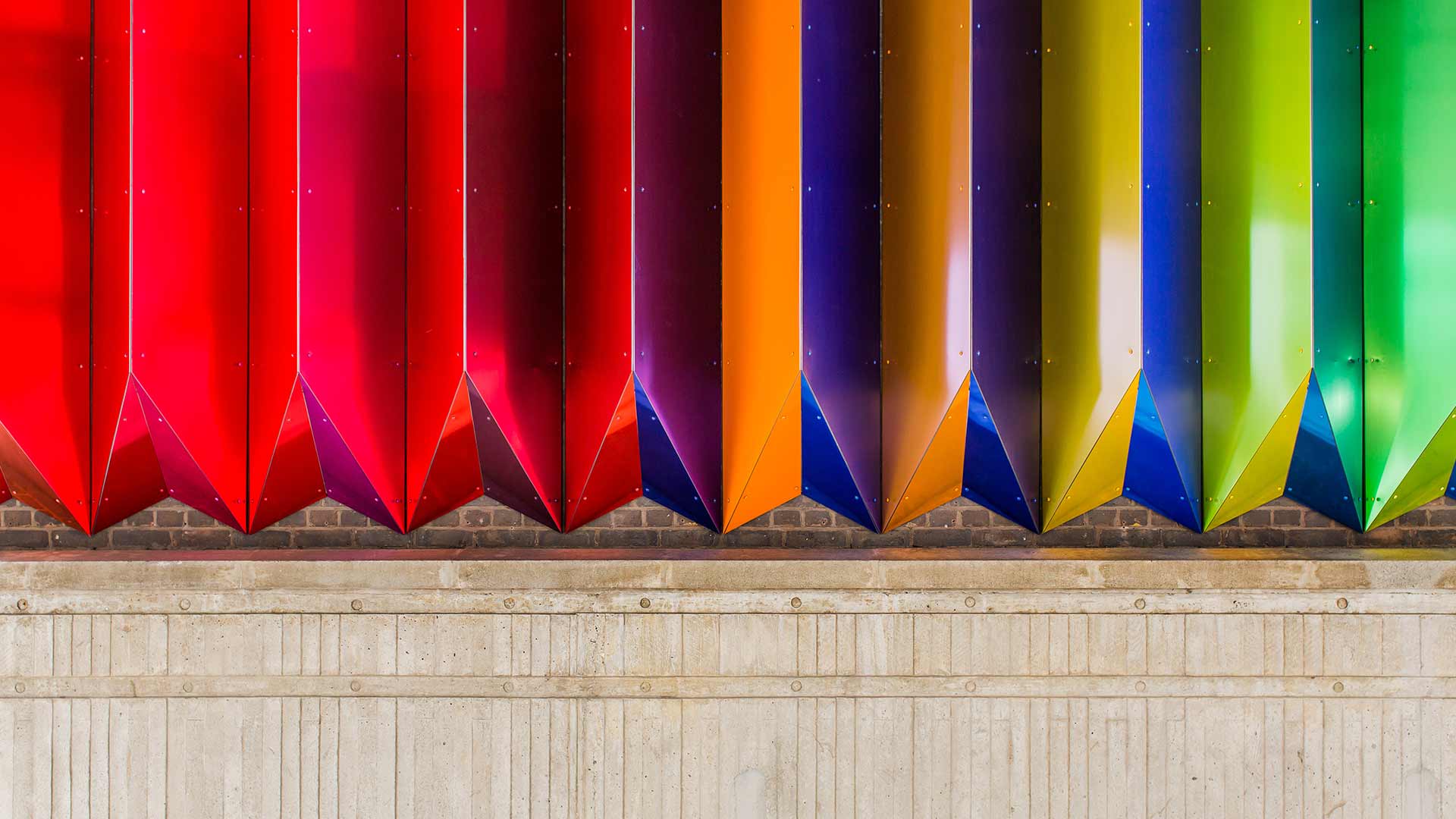Simplicity, geometry and colour
As part of my ongoing research on colour theory, I talk with artist Liz West about ways of seeing and creating, simplicity and distraction, and the generation of ideas.
Let’s start with talking about the luminous surface. Can you describe your relationship with light and colour, and why it’s important to you?
It’s so hard to answer that because it’s multifaceted. It’s many things, not just one singular thing. It’s about being a sensory person in a world that is super sensory. My most vivid memories of childhood are based on light and colour, not necessarily together but sometimes. These experiences would be in a car, my dad driving through Barnsley town centre, which at the time was lit with incandescent and neon lights. The light was much warmer then, an enticing glow.
I was always very perceptive, even as a child, and I would pay attention to the reflections on the floor, particularly on the wet floor so common in the north of England. I found it really alluring. I have a lot of memories of being driven about places and being in transit. I’m the daughter of two artists so I got taken to places often – galleries, museums, dinner parties.
Do you think that, being the child of artists, they honed this sense of seeing?
I witnessed them being artists in the house as their studios were at home. The shelves were full of art books and some of them were quite explicit. There were no holds barred with their interests and what they’d bring into the house. In fact I think I was just allowed to do things and express myself through being creative. I knew that being an artist was possible and never questioned that – I just thought I’d do it and see.
And have you always been creative?
Yes. For as long as I can remember. My first memories are of being sat at a little table in my mum’s studio and being given bits and bobs to play with – art materials and PVA glue, paint and ink, Fuzzy Felt and Lego. And that is what I remember, I don’t remember toys that made electronic sounds – I never had those. Play was making art.
So really you created your own ‘toys’ rather than using prefabricated ones?
Absolutely. The rules that I would give myself as methods of play or entertainment were always self-led rather than being propositioned by a toy manufacturer. Maybe it’s what set me up to be able to think of new ideas for new situations – even those times when I go on site and panic, often I know instantly what to do. I’m very aware that some people have no creative bones in their body and will find what I do impossible but it was instilled in me from a very young age. And now I’ve got my own child, whilst he’s still very young, I’m like ‘come on!’ with the crayons I put in front of him.
Articulating the reason light and colour are important to you is difficult, it is multifaceted, as you say. But also the experience of it is multifaceted, a lifetime’s experience: it’s about what has been, what is, and what will come.
Yes. You can’t explain it in a sentence, in a paragraph, even an essay. You mentioned ‘what will come’, and I went to Stockholm to give a talk recently and a Swedish lighting designer was talking to me about two architects she knew who are in their fifties, their kids are all grown up, and they’re doing their best work now. And it made me think, for the very first time, that my best work might be to come. I never thought that I might have the best years of my life to come. Losing a parent puts that into sharp perspective. My dad died relatively young, so I think, well, I might not have all that time and you realise that you have to live for the here and now.
And what does best mean in this context? Happiest? Most content? And is this in relation to your artistic output or your personal life?
Both. My output is my life. I can’t separate the two. I put so much pressure on myself. Too much. I can’t help it. I am my work. What I create is a self-portrait.
It isn’t straightforward. It can’t be. Going back to your relationship to light and colour, how does that relate to physical space and human experience more generally?
Because we’re so bombarded all of the time, what I want to do is quieten life down a bit. I want to give people the experience of purity.
In my mind, purity is a single colour, or the gradient of the spectrum, or the explanation of how colour theory works, or how the science of light works – to me these are all pure things. I think the threads running through my work, the voice within my work, are those of simplicity, perspective, symmetry, repetition. Things that take your eye on a journey. It’s important that there’s nothing else in the room to distract that. So it’s all circles, or it’s all lines. It’s all continuous.
I think we need to be taken out of the ordinary and put into the extraordinary. I’m not professing here that my work is extraordinary but it is about giving people an experience that they might not have day-to-day.
But purity and simplicity could be seen as ordinary, rather than extraordinary?
For me, it’s the way it’s done. For example, I choose to put one pure colour in a room – it’s not distracted with fire extinguishers, or grass, or railings, or flashing lights – it’s just the one thing. That’s what I try and strive for, to do one thing at a time and do it really well.
And does this simple straightforward approach reflect what you were saying about trying to live your life in the here and now?
I have two sides; I’m really quite serious, particularly about my work and as a collaborator on projects. I know what I want, I have a clear vision and I’m able to articulate my ideas. But then I have this other side to me, this wannabe popstar, where I want to be on stage and I want to be going on mad girly nights out. And I just don’t get the opportunity to behave like that. I guess that comes out in the colours I use, like the vibrancy and theatre of being in a 90s pop video, but my approach to work is serious.
And the experience of your work can be serious. Whilst these interventions in public spaces are themselves moments of joy, they are not flamboyant or juvenile. Of the responses you’ve heard of people seeing your work, what’s most resonated with you?
I’m going to base this on Our Colour Reflection in St Albans, which is one of my latest installations and has been very popular. People have turned up not necessarily expecting to see this piece, they’re just taking a child to the museum and stumble across it. One response on Instagram said something like ‘I was feeling really low today, had a lot on my mind recently, life’s been tough. I walked into this room and my heart lifted, my soul lifted’. I wish I could do this to myself. In asking people to see what they would not normally see, I have been able to remove people from their daily grind, the mundane – and provide a more bodily experience. Children have very intuitive responses to it. Someone asked if we could play a giant game of tiddlywinks! They’re all touching on something within me that I wish I could pull out of myself.
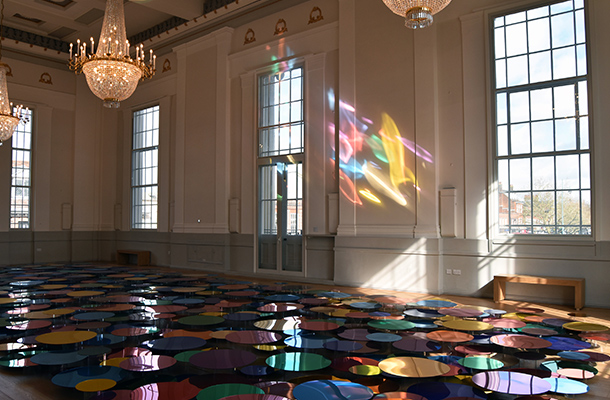
Our Colour Reflection © Inna Allen
Or that you have pulled out of you, but for others?
Yes, exactly. When I make work, I make it in my mind. Then it goes over to a team of fabricators, commissioners, architects, lighting consultants, structural engineers – it’s a team effort, managed by me – and it’s put on public display. And it’s at that point that I feel my ownership of it shift and it becomes public property. Everyone owns a bit of it because they have their public experience of it.
And what about stuff that goes wrong in the process?
Well there’s the big stuff that goes wrong, and the little stuff that goes wrong. The little stuff you can forget about. It might be that you really had your heart set on one material and then you’re told that it’s not meant for permanent installation. Or you wake up in the middle of the night thinking ‘does the architect know that I need this in the drawing for it to work?!’. And you make the phone call in the morning and of course they’ve got it in! Then there’s the big things, like planning permission – you’re told there’s only one round, but there’s two, three…
You’ve touched on purity of colour, geometry, symmetry. When you’re starting to conceptualise for a new work do you think about colour, or shape, or is there something even before that?
I have a very clear idea from very early on, a clear sense in my mind’s eye about what the materials will look like, how the scale feels on the body. One of the treats of eavesdropping on visitors to your work is that it might do things to people that I didn’t imagine would happen. I’m thinking about Aglow in Paris and Dubai: in my mind I knew exactly what it would feel like, how the materials would act to sunlight (and I’m dying to put it under UV light); then people bring their own memories and experiences of the world and put it onto their experience of the art. I can only put my own experiences onto the art. And when I’ve made coloured rooms, I hope people try and meditate in each colour and think about what these colours mean to them. And then people surprise me all the time! It’s nice.
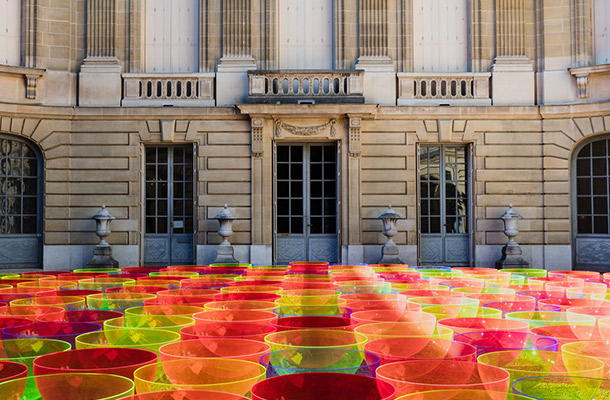
Aglow © Julien Philippy
That element of surprise, that feeling of being taken out of yourself when experiencing your work, whilst you can’t get that from your own work because you have a very different relationship to it, are there artists or places or experiences that will do that for you?
I’m not very confident, which is weird, because my work is very confident. I do lots of artist talks and speak to people about my work but I am hard on myself. I’m inspired by a certain type of art. Definitely immersive, environments that you step into. I see lots of other people’s work – designers, architects, artists – and I think ‘wow’. I know how they’ve made it, I’m knowledgeable enough about materials and how they react – I just think, ‘I wish I could have done that’.
I know that it’s important to you that people experience your work, and don’t just see the photographs of it. I understand that, because an image is a representational thing.
And an image can be a lie as well. What started the ball rolling in my career were the images of Your Colour Perception at Federation House in Manchester. It was the piece that got spread around the internet, got me noticed by the lighting community. All sorts of people saw my work for the first time. And it was a great piece for people to see because it was a really great representation of what I’m passionate about and what I want to be remembered for as an artist. Images of that work were taken by a friend, the memory card was handed to me at the end of the night, I lifted them straight off the memory card and uploaded them to my computer. I didn’t even have Photoshop – people can’t believe they’re not edited – and published them on the internet that evening. People don’t believe it was a real space, in real time. Still! People think it was altered digitally. Or people say ‘can we exhibit the photographs of your work?’ and I have to remind them that it was in a space, the images are just documentation.
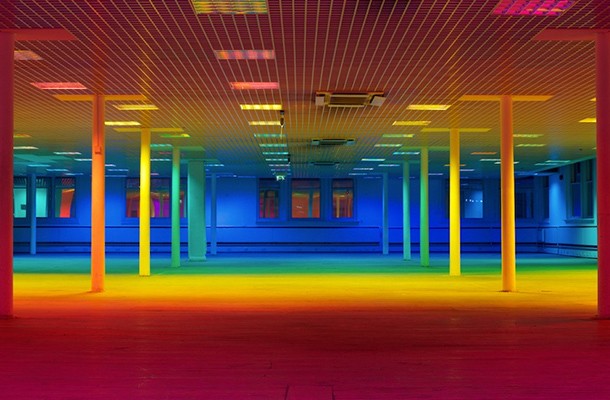
Your Colour Perception © Stephen Iles
There’s something very important about space in your work. So, if Liz ruled the world… Take a city – Manchester, London, anywhere – and consider urban planning, darkness/light, interior/exterior, colour, with a master plan view of how space is used. What would you do tomorrow?
I’d change all cold white light to warm white light!
Bring back low-pressure sodium lamps?
No! Too orange. I was flying into Manchester recently and realised just how many orange lights there still are. My memory of walking down the street in the winter time was orange snow. Everything was orange.
I love colour but I’m striving to paint my house white, or various shades of white. And I’m very careful that I choose warm white light bulbs. But there are big cultural differences here: in the Nordic regions they go for warm cosy light, in southern Europe, they want cooler bright light because it’s so hot outside and they want to instantly feel cooler when they go inside. In the UK, when you’re driving up a road at dusk when the curtains are still open and you see inside people’s houses, the quality of the light they’re living under is so poor – they have the big central light on, far too bright. Or they don’t switch on any lights until it’s late, it seems to be to do with time rather than darkness!
So if I ruled the world, I’d go around to everyone’s home and switch up how they were using lighting in the house. I think that would have a huge impact on their mental health.
Going back to your work: playing, prototyping, testing, scribbling – how much time do you spend with physical materials?
Not as much time as I would like!
I’m often asked if I want to put forward a proposal for a commission, which gives me a chance to think about what I want to do. When I’m not being approached, I struggle, because I don’t have a studio practice like quite a lot of my contemporaries do. And at the moment, people are waiting to see what happens after Brexit. It’s very, very evident that’s happening. People aren’t committing to anything. End of last year, beginning of this year, I had a lot of positive meetings but recently, nothing. And I know that’s not a representation of me as an artist. It’s frustrating and it’s across the board.
You mentioned that for your new home, which is a sort of canvas for your ideas, that the interiors are going to be predominantly white?
Yep, all white. With warm white light bulbs. You can imagine! I even went to Farrow & Ball in Cambridge recently to look at paint for a bathroom vanity unit I’m painting, which will be the only bit of colour in the room. I ended up having this really interesting conversation with the lady in there about colour. How in different lighting conditions colours looks completely different. I thought, well, there’s a starting point for a new work based on colour theory!
I’ve not had conversations with people for a long time that have inspired me to make work. And I struggle to go into my studio and potter, I’d think I was wasting my time. But my husband, who’s a curator, said ‘why don’t you just start making something? Start with making a maquette of Colour Transfer at Paddington? Or make a maquette of all the works you’ve got drawings for that haven’t been built yet?’. Something to get me going. Because I tried making paintings earlier in the year but my skills don’t live up to the very clear ideas I have about what I want something to look like. I found the paintings frustrating because they weren’t exacting enough, so why not scrap that and do something I can do? And I can put a Stanley knife to some card and make a maquette that’s representative of my idea. So that’s what I’m going to try and do more of. I’ve just ordered a load of dot stickers in different sizes, and I enjoy using graph paper because of its rigidity, its seriousness. It gives me a grid, and structure to work on. I’m quite scared of plain white pieces of paper.
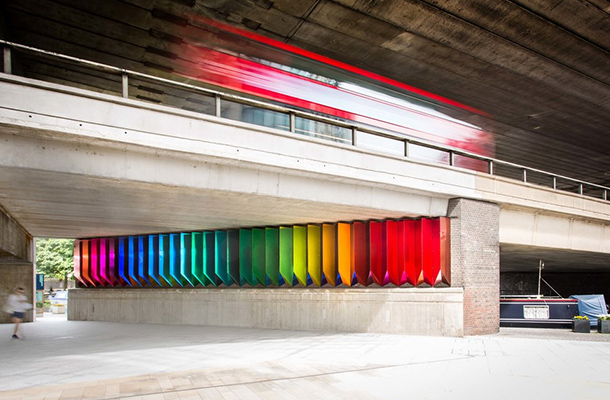
Colour Transfer © Jason Bailey
What do you mean by scared?
I don’t know where to start. I need and like structure. But I also aesthetically quite like grids because they remind me of what I strive for in my work, which is very structured – lines, everything has to match up, nothing can be out of place. Yes, my CD collection is alphabetical. I’d like to get my graph paper out and start cutting up my dot stickers and start making visualisations, just be playful.
So do you go back to five-year-old Liz playing with her Fuzzy Felt and connect with her?
I need to connect with her because I know that by doing, I will arrive at something.
And do arrive at something!
I don’t make that much work really. I aim to make three big pieces a year. I don’t really have a huge output, it’s not like Studio Olafur Eliasson.
But I would love to have more team input. I’d love to take my morning coffee to a meeting with a team of people and say, ‘right folks, I’ve had these ideas, let’s make them happen!’
I’ve been working with an artist called Emma Smith, who has never worked with light as a medium before. She organised a series of workshops and asked people ‘we are…?’ and people fed back to her. She ended up with this amazing pot of information and made a poem out of it. And she’s taken two of the things that people said, which are ‘we are alone’ and ‘we are all one’ and made a big neon sign that flickers between the two statements. It’s very clever. She’s super philosophical, she went to Goldsmiths and half of her degree was in philosophy. Her idea seems to come before the visualisation, whereas for me, the visualisation often comes before the idea.
I met Emma’s father, Ken, at her exhibition launch. He asked me what role I’d played in this, so I explained that Emma had never worked with light before and that I helped her with information about neon fabricators and light sources. She thought about using LEDs because it was the latest technology but she wanted to use them to make it look like neon, so I asked her why not just use neon?! If it’s neon you want, then go for it!
So I explained this all to her dad and then he asked me what I did, so I explained that I was also an artist and showed him some of my work. And his response was, ‘Oh light!’ and then he said, obviously a philosophical thinker too, ‘I have a friend who works in chemistry, who writes an annual newsletter about his work in chemical compounds to send to people on his Christmas card list’ (and I’m thinking, right, okay…) ‘and at the end of last year he posed a question. He said, “is light crystallised time?”’.
Ken asked me, seriously, if I could answer the question – which I could not! He said he couldn’t either, that he’d been pondering it for months. It’s a physical question, not a philosophical one. Anyway I just thought, I’m writing that down! That could be a title, or a starting point for a project, ‘Is Light Crystallised Time?’.
So this conversation with Ken, and the one with the lady in Farrow & Ball, made me think that I’ve not been stimulated enough. I’m saying this to you because it’s a way in. It’s a starting point. In two years’ time, you might see the fruits of it.
There’s something you’re also saying about differences between solo work and collaborative work here…
I think I’d be great with dancers, scientists – not other artists. This is why I feel envious of the big studios, where the artist can sit down, someone around the table might pose a question like, ‘Is light crystallised time?’ and then they can spend the next week researching, mocking it up, talking to people. How exciting!
Yes, tussling with an idea – that almost dangerous place of instability or unknowing. I can see why that’s exciting to you and why you would want that.
I love teamwork. I feel energised when I’m in a team, in the throws of a commission, and call the fabricators I usually work with and ask what they think about a certain type of aluminium. It’s an exciting place to be.
www.liz-west.com / Liz West Instagram
Blog post by Jen Tomkins
Banner Image – Colour Transfer © Jason Bailey


